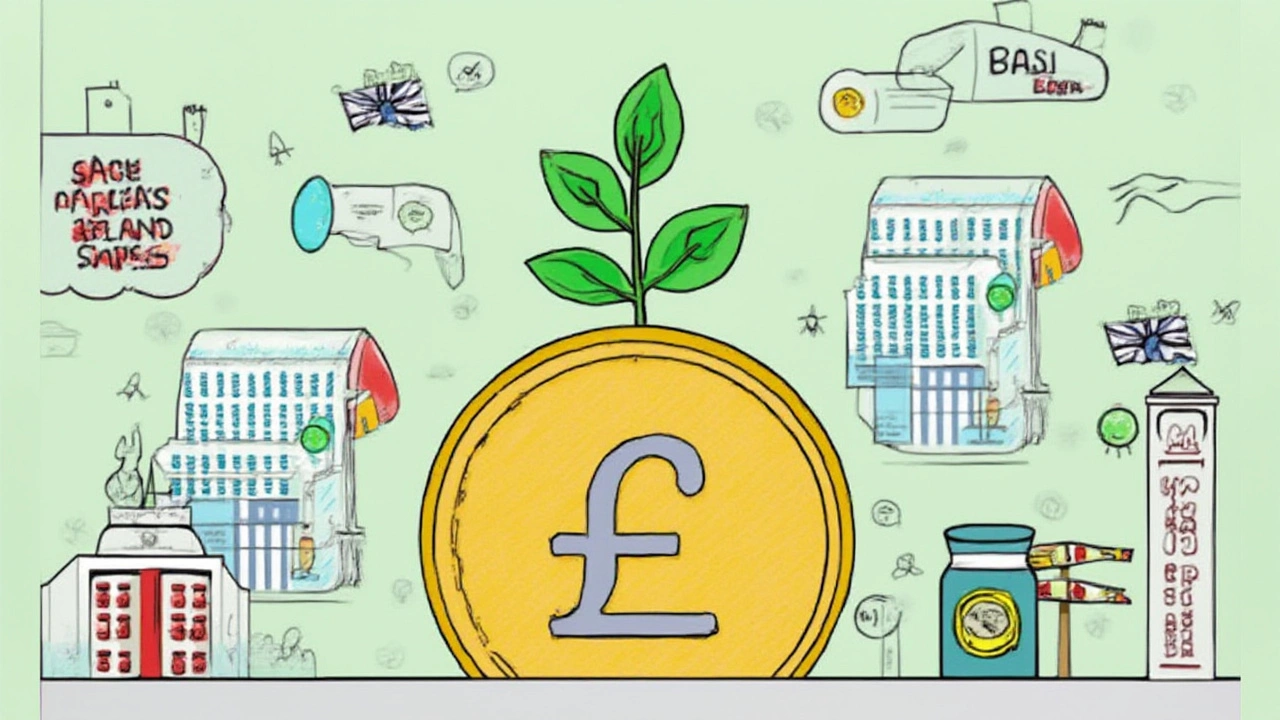Ever looked at your bank balance and wondered, “If I park $1,000 somewhere safe, how much will it actually grow in a year?” Not as much as winning the lottery, sure, but picking the right place for your cash can give you a decent boost—enough for a nice meal out, or a sneaky guilt-free splurge (I’m not judging). What matters is how you let your money get to work: is it chilling in a boring old checking account, or hustling hard in a high-yield place? Let’s find out what $1000 can really do for you in 12 months, using numbers from July 2025.
What Controls How Much Interest $1,000 Makes?
Making your $1,000 earn interest is a bit like deciding whether you want your money relaxing at a lazy day spa or running a marathon. The difference comes from interest rates, compounding frequency, and, of course, where you park those dollars. Right now, banks are offering a pretty wide range—from classic savings accounts that try to impress with 0.01% (yawn), to online banks and credit unions dishing out 4.5% to 5.3% if you know where to look. And don’t even get me started on the tiny yields at traditional brick-and-mortar banks. To help you see what’s really possible, here’s a quick table of rates as of summer 2025:
| Account Type | Example Rate (APY) | Interest Earned on $1,000 (1 Year, Compounded Monthly) |
|---|---|---|
| Traditional Bank Savings | 0.02% | $0.20 |
| Credit Union Savings | 1.60% | $16.08 |
| Online Savings Account | 4.90% | $49.97 |
| 12-Month CD (Certificate of Deposit) | 5.20% | $52.00 |
| High-Yield Money Market | 4.85% | $49.58 |
Now, let’s talk cracking through the jargon. “APY” stands for Annual Percentage Yield. It factors in the effect of compounding—the magic that lets you earn interest on your interest. The more often your interest is paid and added back to your balance, the bigger your pot grows (even if just a smidge each time). Most banks use monthly compounding, but some online accounts and CDs do it daily or quarterly. Here’s the gist: if your $1,000 sits in a standard bank savings account, you’ll probably make a whopping 20 cents over a year—hardly a reason to celebrate. But an online savings account or a one-year CD could net you almost $50, or just over $4 a month. That’s a delivery pizza every month, just for letting your money sit.
Keep in mind, rates can shift. Right now, banks are still riding the high-interest wave set by the Federal Reserve’s actions post-pandemic. This means high-yield savings accounts and CDs are genuinely rewarding savers in 2025, but don’t assume today’s rates last forever. If you open a 12-month CD, your rate gets locked in, like a frozen pizza you know you’ll want later—no surprises, no sudden drops. With regular savings, the bank can change rates tomorrow, up or down, which is something to remember if you’re planning long-term.

How to Calculate Interest Earnings by Hand—or With a Calculator
If math class left you with cold sweats, don’t worry. Calculating your interest doesn’t take a PhD or a monster spreadsheet. Here’s the simplest way most banks do it: the compound interest formula. It goes like this:
- Future Value = $1,000 × (1 + r/n)^(n×t)
The letters just mean:
- r = annual interest rate, as a decimal
- n = number of times the interest compounds per year (12 for monthly, 1 for annually, etc.)
- t = number of years (so, for 1 year, that’s just 1)
Realistically, most of us aren’t plugging this into a calculator. Instead, online banks and most major banks offer savings calculators—just punch in your deposit, pick a rate, set your compounding period, and see the future. Still, knowing how it works helps you spot if something feels off with a bank’s promised numbers. Here’s how it plays out for a 4.9% APY, compounded monthly on $1,000:
- APY: 0.049
- Compounding: 12 times per year
- So: $1,000 × (1 + 0.049/12)^(12 × 1) = $1,049.97. That’s $49.97 earned.
High-yield accounts multiply this effect, especially if you leave the money untouched. If you add more cash throughout the year, your actual interest will be higher. But let’s keep it simple and say you only ever put in $1,000, never another penny. Even then, your $1000 in a top online account grows about 250 times faster than in those old-school brick-and-mortar banks.
Some folks ask, can you “stack” returns by moving money every few months to chase the highest promo rates? Sure, but banks know this game. Taking advantage of brief promo rates often means you lose out when it drops. Unless you have time for bank account juggling, most people are better off picking a solid, consistently high-yield account and letting the compound interest snowball do its thing. I once tried to “rate chase” with three accounts in one year and ended up with a stack of paperwork, random forgotten passwords, and only an extra $6.73 for my trouble. I let Graham laugh at me, but it was a good lesson learned.
One more thing—taxes. Interest from savings accounts or CDs gets taxed as regular income. So when you’re thinking about those annual returns, remember that the IRS will want its cut (unless you’re stashing your $1,000 in a Roth IRA, which changes the math and the rules totally).

Tips and Things You Might Not Expect When Saving ,000
Getting the most interest from your $1,000 isn’t about chasing a unicorn bank with magical rates. It’s about picking a good account, automating your savings, and dodging things that eat into your earnings—like fees or forgetting about taxes. Sometimes, the little details make the biggest difference. Here are some things I’ve learned from my own savings adventures and hours of research (usually while trying to “help” Graham…shh, don’t tell him):
- Know your APY: Banks love to brag about “leading rates” but look closer—sometimes a sky-high APY is just a 3-month promo, not standard. Always ask what the ongoing APY is.
- Watch for minimums: Some accounts advertise a 4.9% APY but require a $10,000 minimum. For $1,000, make sure you check those fine print details.
- No-fee is king: Hidden monthly fees or requirement charges can absolutely wipe out your interest. There’s no point earning $15 if a $6 maintenance fee eats half of it.
- “Compound” isn’t just a fancy word: Always choose an account that compounds at least monthly or, better yet, daily. This genuinely increases your return—tiny but real.
- Safety check: FDIC or NCUA insurance means your money’s protected up to $250,000. Don’t get cute with accounts that aren’t covered. Earning an extra percent isn’t worth losing your savings to a random fintech collapse.
- Try laddering: With CDs, you can build a “ladder”—split your $1,000 into $250 chunks across 3-month, 6-month, 9-month, and 12-month CDs. As each matures, you roll into a new one. This lets you earn higher rates without locking up all your cash at once.
- Watch the inflation boogeyman: Even in 2025, inflation is still nibbling away at buying power. Earning 5% APY is good, but if inflation’s running at 3.5%, your “real” gain is closer to 1.5%. It beats nothing, but don’t spend it all in one place!
- Savings hacks: Use an online savings account just a little bit out of reach (no debit card, no ATM access) so you’re not tempted to dip in for impulse spending. Out of sight, out of mind—more money grows.
- Set goals: If $49 feels tiny, use it as a launching pad—set up automatic transfers so you add $10 or $25 a month. Suddenly, your interest spirals upward faster.
- Keep learning: The top rates are never set-and-forget forever. Once a year, check your rate, peek at what else is out there, and move if it makes sense.
A lot of people feel like only the rich make money on interest, but the reality is anyone can optimize their returns—it just takes a minute to hunt down the best deal. As of July 2025, savvy savers are earning more than $50 a year on just $1,000 without risk, as long as they use an online high-yield account or short-term CD and dodge unnecessary fees. Traditional savings accounts simply don’t make sense if you care about growing your money beyond spare change. Turning $1,000 into $1,050 isn’t life-changing, but it’s free money with zero effort and no risk. My advice? Treat your savings account like your favorite cozy corner at home—make it work for you, and check in now and then. Who knows, by next July, that interest might just pay for your next big goal—or at least another decent pizza night.
